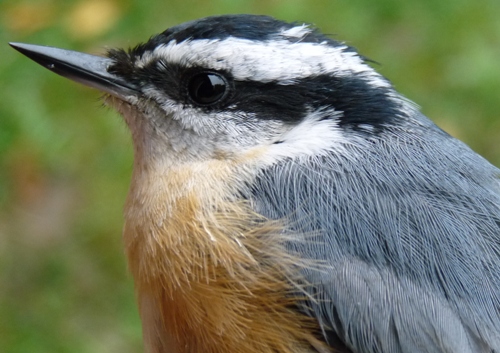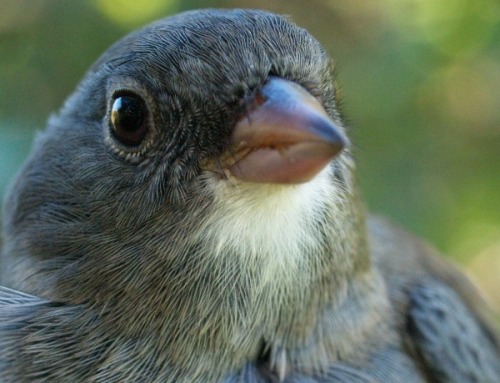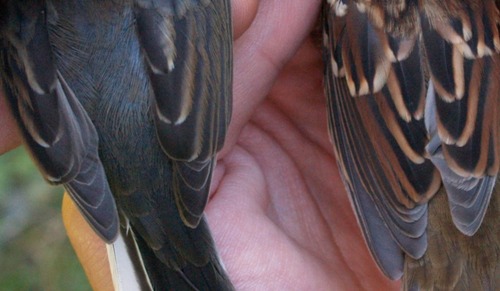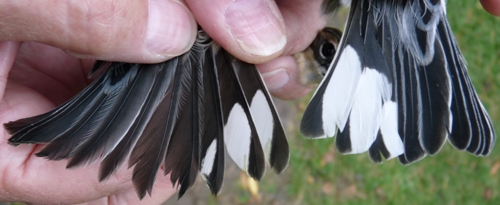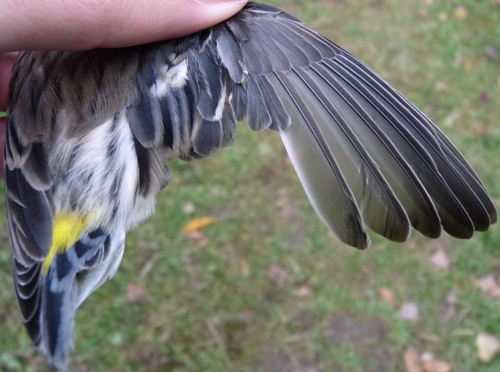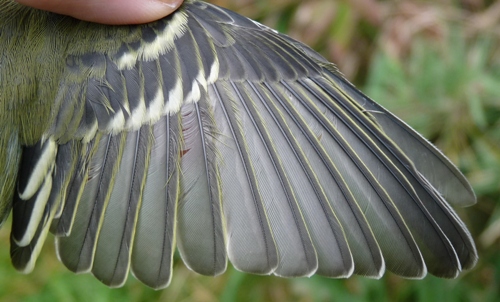|
McGILL BIRD OBSERVATORY |
|||||||||||||||||||||||||||||||||||||||||||||||||||||||||||||||||||||||
Welcome
to the McGill Bird Observatory weekly report.
Click here for a complete listing of our archives.
Banders-in-charge: Simon Duval, Marcel Gahbauer, Kristen Keyes Notes: Based on past precedent we had anticipated that week 10 was most likely to be the peak of this year's fall migration, and so Marcel Gahbauer returned for the week to help share the banding load with Simon, doubling up on most days. For the third week in a row it was again very busy day after day, though overall the volume was actually down slightly from weeks 8 and 9. Our efforts were substantially restricted on three days due to rain and wind, but we still banded another 1017 birds this week, including at least 125 daily except for Thursday when we could only squeeze in a few net hours between rain showers. On Saturday, the final day of week 10, we broke another significant record when we passed the total of 5101 which was our previous high for an entire season, set in 2008 when we last had a major influx of Yellow-rumped Warblers. As over the previous two weeks, we are grateful to our volunteer team for helping us handle these large numbers so efficiently; special thanks this time to Steve Dumont, who drove down to MBO from Gaspésie for five days and nights of helping us with extraction during our peak period. Speaking of Yellow-rumped Warblers, we thought that the sharp cold front that came through the night between weeks 9 and 10 might finally prompt their numbers to drop, but the change in abundance was slight at best. For the first three days this week, we were still banding over 100 of them each day, and although that tally declined gradually to just over 50 by the end of the week, it still added up to another 606, bringing the total for the season to an incredible 2266, now representing 44% of the birds banded at MBO this fall, and placing them more than 2000 individuals ahead of our second-most banded species, White-throated Sparrow (with 263 individuals to date). Removing Yellow-rumped Warbler from the total gives 2895 other birds banded to this point in the season, which is still above the range of 2005 to 2689 observed in most previous years (in 2008 when we also had a substantial influx of Yellow-rumped Warblers, we were at 4129 total birds by the end of week 10, including just over 1500 Yellow-rumped Warblers). For a third week in a row we banded birds at an average pace of over 250 individuals per 100 net hours - in fact the lowest daily rate over the past three weeks is 161 / 100 hours. Our rate of capture for the fall season has now more than doubled over the past three weeks, and our all-time rate dating back to 2004 has risen by over 10% during this short period! Another way of summarizing how incredible the past three weeks has been is to note that the total of 3381 birds banded over that period nearly matches the 3390 over the entire 13-week fall season last year! Also of note this week, we banded just 24 species, far below the count of 36 to 40 at this time in four of the previous five years - only in 2006 did we have similarly low diversity (23 species). This could be another reflection of our seemingly early-shifted migration, since diversity drops off sharply in week 11 in most years. On the other hand, the 81 species observed this week was a record high for week 10, an especially conspicuous result in a season where diversity has tended to be below average.
Thanks to having two banders on site throughout the week, we were able to have one or the other outside much of the time to watch for migrants flying well above our nets, which no doubt contributed to the high count of species observed this week. This paid off particularly well already on the first morning of the week, when we experienced a record flight of raptors over MBO, adding up to 132 individuals of 11 species, including 55 Red-tailed Hawks, 30 Turkey Vultures, 21 Sharp-shinned Hawks, 8 Cooper's Hawks, 5 Northern Harriers, 4 Broad-winged Hawks, 3 Bald Eagles, 2 Northern Goshawks, 2 Red-shouldered Hawks, and singles of Osprey and Merlin. The strong raptor movement was part of a total of 55 species observed for the day, the highest count this fall. The sightings of Bald Eagle and Osprey were the first for fall; over the course of the week, another 7 new species for the season were recorded: American Black Duck, Green-winged Teal, Rough-legged Hawk (unusually early), Great Black-backed Gull, American Pipit, Eastern Bluebird, and Savannah Sparrow. Among those species, the rough-leg, pipit and bluebird were new for all of 2010. We also banded our first Red-breasted Nuthatch of the year, and our first Fox Sparrow of fall, also earlier than usual. Of particular interest this week were two returns - a Blue Jay banded at MBO on 28 August 2009, and a Yellow-rumped Warbler banded here during the big migration of 2008 on October 15. It's possible the Blue Jay has remained more or less in the area since we first banded it, but the Yellow-rumped Warbler is definitely a migrant, and it's rare to get evidence like this of fidelity to migratory routes.
Although the number of Yellow-rumped Warblers banded this week dropped by nearly one-third from week 9, the total of 606 individuals was still almost five times greater than the second-place species, Slate-colored Junco - despite the fact this was the second-highest weekly count of juncos ever banded at MBO. Ruby-crowned Kinglet inched down into third place, the first time it has not been in the top two for week 10. White-throated Sparrow slipped down to fourth, while Golden-crowned Kinglet moved up to fifth place, with the highest single-week total for this species in MBO's history (and actually more this week than in all of 2009). Other new additions to this week's list include White-crowned Sparrow, Hermit Thrush, and Blue-headed Vireo, sharing the bottom half of the top ten with Song Sparrow and Black-capped Chickadee. Canada Goose remained in the top spot among species observed, not surprising as it has held this spot in week 10 every fall. The large goose flocks kept Yellow-rumped Warbler in second place, even though the impressive count increased slightly from last week to average just over 250 individuals on site daily, another new record. There were also increasingly large flocks of Red-winged Blackbird, American Crow, and American Robin this week, reflecting how MBO was just teeming with birds this week. Even if the flocks of geese passing overhead are taken out of the total, the rest of the top ten species alone accounted for an average of 1069 birds observed each day. Although the average count of 70 White-throated Sparrows was only enough for sixth place, they were particularly conspicuous as many of them were singing around dawn most mornings. Blue Jay numbers have finally started to taper off, but that was offset by an early influx of Slate-colored Juncos in numbers not usually seen until week 13. The junco and European Starling were new additions to this week's list, displacing Black-capped Chickadee and American Goldfinch from last week's top ten. Three weeks remain in our sixth year of fall migration monitoring at MBO. The number of birds banded during this part of the season has ranged from 537 to 972 in previous years (mean 781). With migration remaining strong at the end of week 10, it seems like there is a good chance numbers this year will be at or beyond the high end of that range, meaning that we could easily end up surpassing 6000 birds banded this fall. Finally for this week, a brief report on the Northern Saw-whet Owl migration monitoring program, which has been taking place nightly except when rained out (which was just once this week). Our total for the past seven days was a fairly modest 16 birds banded, a bit disappointing perhaps, given that we had 7 on the first night of the week and then watched the numbers gradually taper off to zero by the final night. On the big night, we also had our first foreign recovery of the season, which we quickly learned was a female banded as a hatch-year bird during migration on October 19 last year (2009), roughly 60 km southwest of Boston. Although our owl monitoring coverage has been incomplete in previous years, our peak has always been just before mid-October, so we expect that next week's numbers will be higher. Meanwhile, the local Long-eared Owls kept us entertained most nights this week, with two individuals occupying regular perches on either side of Stoneycroft Pond and usually vocalizing throughout the evening, including one call that sounds remarkably like that of a Black-bellied Plover, and is apparently usually given only by young Long-eared Owls.
|

